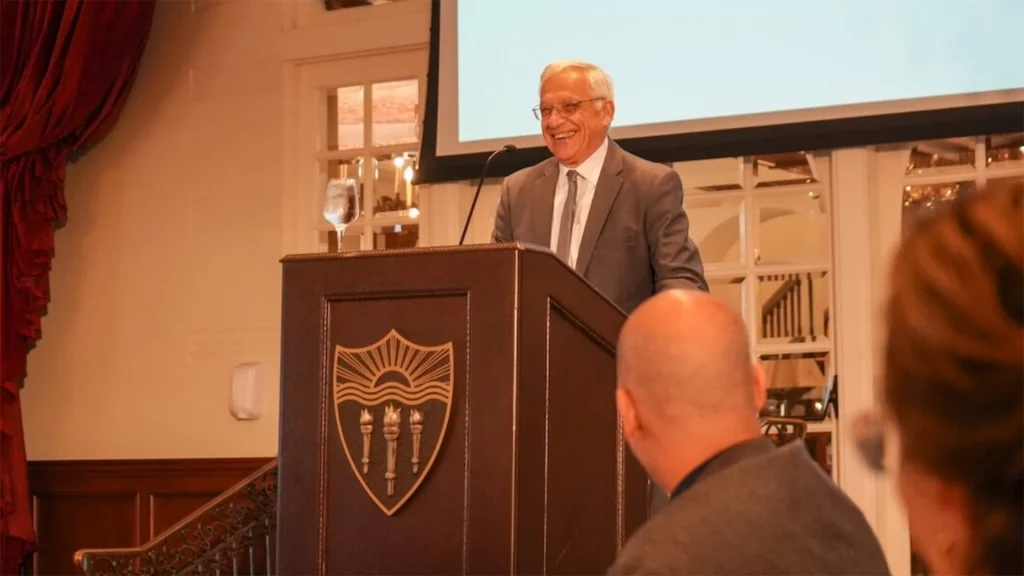In this essay, Dean Yannis C. Yortsos, Dean of the USC Viterbi School of Engineering; Zohrab Kaprielian Dean’s Chair in Engineering, introduces a new equation to sum up the expansive present – and exciting future – of Viterbi School of Engineering, with all its constituent parts.

PHOTO BY DANI ORLANDO
In my annual State of the School address recently, I shared the USC Viterbi School of Engineering’s major milestones and accomplishments, and reiterated our mission: “to engineer a better world for all humanity, a goal that is shaped and influenced every day by the speed with which technology itself evolves.” I also introduced an equation to sum up the breadth and depth of our school: V=C+2I.
V=C+2I
In this formulation, “V” stands for Viterbi; “C” for campus; and 2I for our two research powerhouses, the USC Information Sciences Institute (ISI) in Marina del Rey and USC Institute for Creative Technologies (ICT) in Playa Vista.
Two years ago, we celebrated the 50th anniversary of ISI. Earlier this year, the 25th of ICT (more on that milestone in a moment). Today, the Viterbi School is a solid amalgamation of three entities: the UPC Campus (which is 119 YEARS old!), ISI, and ICT. Which is why I want everyone to remember this new equation: V=C+2I. It’s the key to unlocking our exciting future.
The world is changing very fast, and a lot of this is technologically driven. And we are at the forefront of it. Research, discovery and innovation are now hyphenated-disciplinary, being increasingly multidisciplinary, interdisciplinary and transdisciplinary. Engineering and technology lie at the core of these intersections.
The result is increasingly converging approaches. Convergence is all around us. And it is not only because it helps solve problems worth our attention. It is also because it becomes an essential part, a raison d’etre, to many of our own subdisciplines.
This is why I wanted a powerful conceptual formula such as V=C+2I to sum up where Viterbi School of Engineering is today – and where we are going tomorrow.
SCHOOL OF ADVANCED COMPUTING
Another aspect within V=C+2I is SAC. Earlier this year, we created the new School of Advanced Computing, part of USC President Carol Folt’s initiative, or “moonshot,” on the Frontiers of Computing.
SAC is part of the USC Viterbi School of Engineering, in a school-within-a-school structure. It includes the Thomas Lord Department of Computer Science, the Ming Hsieh Department of Electrical and Computer Engineering, and a new division of computing education, which incorporates the Information Technology Program (ITP) and a new program in interdisciplinary data sciences.
What is unique are the newly conceived, USC- and Viterbi-wide academic entities, namely groups of “affinity faculty.” These entities will leverage strengths in advanced computing-related interdisciplinary activities across the entire university. For example, in physical sciences, in sustainability, in health, in social sciences or in the arts. A significant number of its members will have a primary academic home outside SAC, in other Viterbi departments, or across the entire university. This novel concept transcends boundaries, encapsulates as tightly as possible hyphenated disciplines, and empowers them all.
ICT 25
Much of Viterbi’s accelerating impact has resulted from the incredible work conducted at ICT, now celebrating its 25th anniversary as a University Affiliated Research Center (UARC). Inspired by its proximity to Hollywood, the vision for ICT was to develop extraordinary new technologies in virtual reality (nascent 25 years ago) and to advance simulation in graphics and immersive environments. In the process, ICT fundamentally anticipated the future of advanced computing and new forms of human-computer interaction.
During its first 25 years, ICT has developed an extraordinary array of new technologies that have applications across many domains. These include award-winning R&D in Artificial Intelligence (AI), Computer Graphics, Geospatial Sciences, Human Performance, Learning Sciences, Modeling, Simulation & Gaming, Mixed Reality (MxR), Medical VR, Narrative, and Virtual Humans. Not surprisingly, ICT has been credited with remarkable success, from publications, to patents, and even two Academy Awards (Science & Technology). At the same time, ICT’s Light Stage technology was used to create 3-D portraits of President Obama in the Smithsonian.
New advances in technology, from AI, ML and to robotics, will surely result in an ever-close intertwining with human action. This domain, therefore, will require us to develop both outstanding technical competence, and also exemplary character, so that the technological results, products, and processes will be used for the upholding of our shared human values.
This fast-emerging double helix, where technology and human centricity closely interact, is fundamental and at the core of ICT research. As we advance what will surely be transformative initiatives within the FoC framework, we look to ICT to continue as an essential contributor to the overall mission of the Viterbi School of Engineering – to help engineer a better world for all humanity.
As ICT celebrates twenty-five years of outstanding work and ingenuity, we believe that its next twenty-five years will also be full of new outstanding achievements, leading in creating new technologies, with a human-centric focus, for a better world. As the 2nd “I” in our new Viterbi School of Engineering equation: V=C+2I, we look to ICT to continue to deliver extraordinary innovation in the years to come.
This essay was adapted from the Dean’s speech on Sept 19th, 2024. To read a fuller commentary of the event, please visit: https://viterbischool.usc.edu/news/2024/09/state-of-the-school-2024-one-equation-to-rule-them-all-at-least-at-usc-viterbi/
![V = C+2I [PHOTO: DANI ORLANDO] V = C+2I [CREDIT: DANI ORLANDO]](https://ict.usc.edu/wp-content/uploads/2024/10/2024-Viterbi-Equation_CREDIT_DANI_ORLANDO-copy.webp)